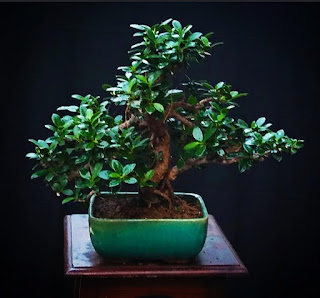The most popular edible fruiting trees suitable for our climate are miniature mandrian orange, Chinese musambi, lemon, tamarind,gooseberry,pomegranat
 |
| Sapota in a bonsai pot |
 |
| Fruiting bonsai in growth pot- belonged to Malini |
While bonsai trees produce smaller branches and leaves ,they always have only regular size flowers and fruits.
Seedlings from seeds may take a long time for flowering and fruiting. Air layered plants, grafted or hybrid ones, even dwarf varieties can produce flowers and fruits
within a short period of time.
Soil
Garden soil, river sand and compost in the ratio 1:1:1 is good as potting mixture. Grow in a grow bag initially ,then repot in a bonsai pot.
Fruiting trees need lots of sunlight. So keep them in a well lit area. Watering should be done when the soil is almost dried out.
Should be done periodically. During winter use low nitrogen fertiliser, in spring nitrogen rich and in summer a balanced fertiliser. This is the general rule for fruiting trees. For optimum fruit production application of a balanced fertiliser, during spring till middle of autumn ie. August, September, October is needed. Feed your tree high dosage of Potash and and Phosphorus- a pinch per pot every month.
Banana peel fertiliser and powdered egg shells: Soak in water and keep aside for a day.
Dilute the mixture with water in the ratio 1:2 and apply early morning or evening once in
3 days. Use the residue for composting.
Another application is a pinch of NPK 18:18:18 in soil once a month and water the plant after the application. Apply sulphate of potash once in every 3months.
Wood ash mixed with water: Apply alternate weeks. Wood ash contains Potassium.
During summer, mulch the trees using grass clippings of grass to maintain humidity.
Maintain shape of the tree by pruning. Prune the growing tips. Winter is the right time to prune custard apple. Mango in spring time, Pomegranate early autumn ie middle of October.
Mealybug and Spider mite are the common pests. Grow marigold, sunflower, onion or garlic near the plant to reduce the incidence of these pests.
Use neem oil, soap solution and tobacco juice, diluted with water and spray affected plants every week till the plant over comes the pest attack.
It is a liquid fertiliser , good for overall growth. It encourages better flowering and fruiting. Soak the comfrey leaves in water for 2 or 3 weeks , stain and spray after mixing with water in the ratio 1:3.
Instead of comfrey use leaves of subabul or drumstick leaves. The solution is stinky but quite effective.





















































